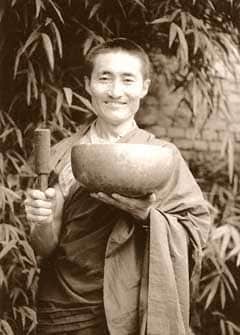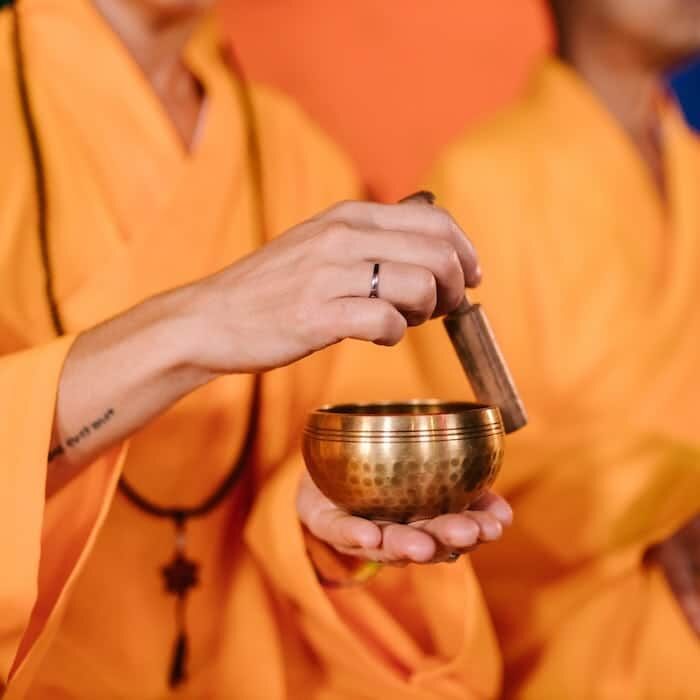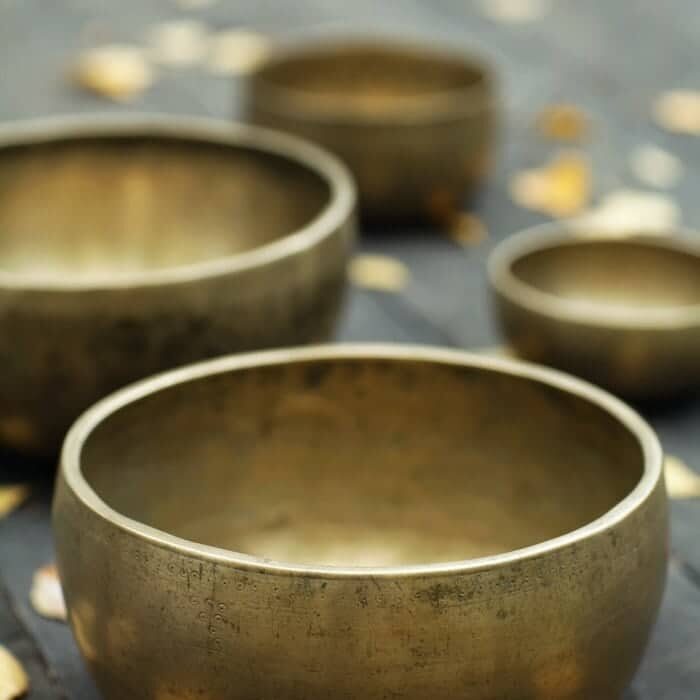Are you familiar with the Tibetan Singing Bowl? You might have heard a friend talk about it, seen one in a yoga studio, or even experienced the sounds they make yourself. Regardless, they create lovely and fascinating soundscapes that can be enjoyed no matter where you are.
Tibetan singing bowls are distinct in their history and use. Some people call them “Himalayan singing bowls” since they originated from the Himalayan region centuries ago. However, they still remain popular choices for meditation tools today.
But what is their history?
We will dive deep into the rich Tibetan singing bowls’ history and explore how they became so beloved worldwide.

Tibetan Singing Bowls History
The exact origins of Tibetan singing bowls are unknown, but they are thought to date back to the Bronze Age. According to research, the tradition of using them in Asia can be traced back over 3,000 years ago.
They were first mentioned in a Chinese text from the 8th century CE and were used by the Bonpo people of Tibet. The Tibetan bowls were used for ritual purposes and were believed to have mystical powers. Sound therapy spread to other parts of Asia and was also used in Japan and Korea.
Few scientists concur that Mesopotamia is where these instruments were initially created more than 5,000 years ago. However, it is widely accepted that they have been utilized for centuries in the Himalayan region. And are used for spiritual and therapeutic purposes.
Also, it is believed to have originated in ancient India and diffused to Tibet, Nepal, and Bhutan via cultural and trade exchange.
During the Tibetan Empire, Buddhist monks used singing bowls in meditation, chanting, and ritual practices. They were also utilized in monasteries to indicate the beginning and end of meditation sessions.
Additionally, these instruments were employed as a traditional form of medicine. They have sound healers utilize the vibrations and sounds generated to treat various ailments.
The earliest singing bowls were made of pure copper. Later, were created from brass, a metal alloy of several different metals, including copper.
Approximately 2,000-year-old brass singing bowls were reportedly discovered in the early 1900s in northern Nepal and India. However, due to political and cultural shifts, the Himalayan region saw a drop in their use throughout the 19th and 20th centuries.
But still, interest in it has been renewed in recent years. They have been adopted by Western practitioners of yoga, meditation, and sound therapy.
Cultural Significance and Traditional Uses of Tibetan Singing Bowls
Tibetan culture is inseparable from Tibetan Buddhism. In Tibetan Buddhism, singing bowls have a deep cultural significance in Tibetan society. They are considered sacred and are employed in various practices and rituals.
They used it in meditation and rituals. Purification ceremonies and offerings to deities are a common practice in Tibetan Buddhism. The sound produced by these instruments is believed to have a calming and meditative effect. It promotes balance and harmony by purifying the mind.
In Tibetan Buddhism, singing bowls are used in conjunction with chanting and reciting mantras. These instruments are struck in a specific pattern to help practitioners enter a meditative state and to enhance their focus on the sound of the mantras.
In purification ceremonies, the sound it produced is believed to have the capability to disperse negative energy. It also establishes a positive and uplifting ambiance, fostering peace and balance.
Himalayan singing bowls are employed in religious ceremonies. Like offerings to deities, to create a positive and auspicious atmosphere. Additionally, they are also utilized in rituals like funerals and memorials. The sound they make is said to guide the spirits of the deceased to the afterlife.
These instruments hold cultural significance as a traditional craft. The skill of creating them is considered an ancient and respected practice. Its creation is passed down through generations of artisans.
Even today, many of it is made by hand using traditional techniques by skilled artisans.
Tibetan singing bowls also hold symbolic significance in Tibetan culture. Their round shape is believed to symbolize the infinite and eternal nature of the universe. While the sound they produce is said to represent the sound and vibrations of the universe.

Rise of Tibetan Singing Bowls in Modern Culture
Tibetan culture influences the rising popularity of Buddhist bowls and their health benefits in Western cultures. Their long history and spiritual importance draw individuals in. Especially those fascinated by the traditional ceremonies and practices of Tibetan Buddhism.
They gained popularity in the West in the 1960s. It started when Westerners traveled to Asia and brought Tibetan singing bowls back with them.
Why Buddhist Bowls Became Popular in the West?
Several factors contribute to its popularity in Western society.
Popular Alternative Medicine
The rising popularity of complementary and alternative medicine is one important factor. Additionally, they have an interest in mindfulness exercises like yoga and meditation.
User-friendly
People are increasingly looking for strategies to lessen stress and enhance well-being. As a result, singing bowls became a more common option because they are simple and can be without specialized knowledge or skills.
Marketability
Tibetan singing bowls have increased in popularity due to their use in therapy, healing, and sound baths. Additionally, the market for them has expanded, with a wide range of options. Consequently, a wider spectrum of people can access it more easily.
Online Access
The internet has also played a major role in spreading information, with people uploading their positive experiences. In addition, the availability of information and resources online has made it easier for anyone to learn how to use them.
Social Media
Many people also share their experiences and positive results on social media. This has led to more people becoming interested in singing bowls.

Cultural Appropriation Debate about Tibetan Singing Bowls
Some argue that the use of singing bowls by non-Tibetans can be seen as cultural appropriation. This involves adopting an artistic practice without understanding or respecting its context or origin.
However, some argue that this instrument is not cultural appropriation. They said it is not unique to one culture, as similarities exist in other cultures, like Japan and China. Also, cultural exchange and sharing of knowledge and practices across cultures can be beneficial for everyone.
It is ultimately up to the individual to consider its cultural and spiritual significance. However, they must be used in a way that is respectful and appropriate. It’s essential to approach any cultural practice with sensitivity. And to also seek knowledge and understand its origins with an open mind.

How to Choose a High-Quality Tibetan Singing Bowl?
It’s important to keep a few things in mind when purchasing a singing bowl to ensure you obtain a high-quality product. Here are some pointers to assist you in choosing wisely:
- Top-notch materials. Bronze, a metal alloy consisting of copper and tin, are their base material. While some contemporaries are created from other materials, such as stainless steel or crystal, bronze is still said to be the best ingredient.
- Check the weight. They should have a substantial weight, giving them a deeper and more resonant sound.
- Expertly constructed. No sharp edges or dents should be present; they should be uniform and smooth.
- Consider the size. They come in various sizes, and your choice will depend on your personal preference and intended use.
- Hand-hammered process. Hand-hammered bowls are considered of higher quality than machine-made. It is due to its more complex and nuanced sounds.
- Testing. Strike them with the wooden mallet and pay attention to their sound. Find that sounds clear and pleasant.
- Purchase from a trustworthy seller. Read client reviews and testimonials. It should always be the first step before buying something online.
- Quality and budget: When it comes to pricing, they can range widely in price, so it’s critical to strike a balance between cost and value.

Overview
Tibetan singing bowls’ history dates back centuries and was traditionally used in Tibetan religious ceremonies and traditional medicine. It is used by Buddhist monks and the Bonpo people of Tibet.
Their resurgence in popularity is due to Westerners who practice yoga, meditation, and sound therapy.
It’s important to consider the materials, weight, construction, size, whether it is hand-hammered, sound quality, and the seller’s reputation when purchasing a Tibetan singing bowl. Using them respectfully and appropriately is also essential, given their cultural significance.
A top-notch Tibetan singing bowl can enrich your spiritual practice. Whether you use it for meditation, sound therapy, or just to enjoy its lovely sound.
Wrap-up
Tibetan singing bowls are fascinating tools for spiritual transformation. They have been used for centuries in mindfulness, deep relaxation, and healing. Their soothing melodies can balance the body and mind—bringing peace and clarity to our lives.
The power of sound therapy continues today as they are found in temples, meditation centers, and homes worldwide.
Whether you’re looking to deepen your spiritual practice or simply want to add a beautiful instrument to your home decor, LifePumpkin’s Tibetan singing bowl can help you achieve both goals with ease.
So what are you waiting for?
Find out more about the ancient powers of these mystical musical instruments right now!





